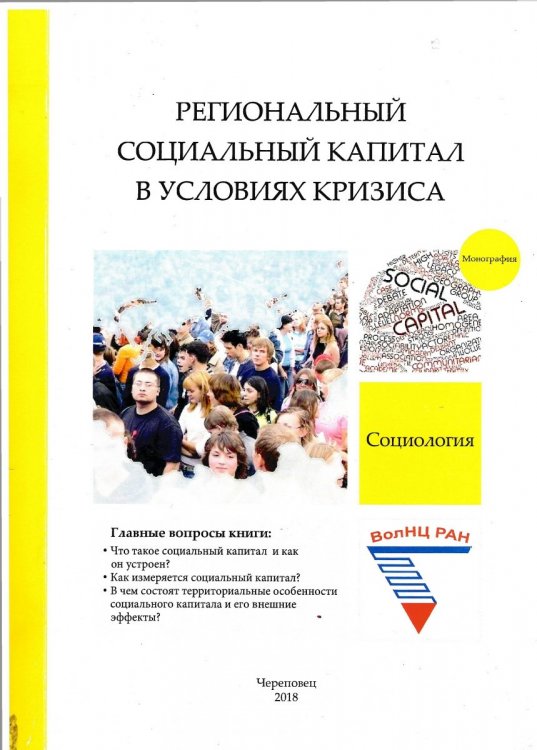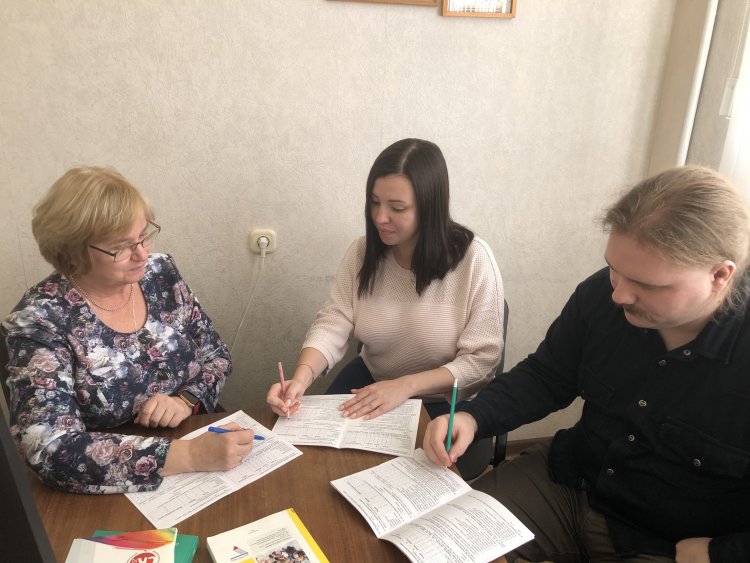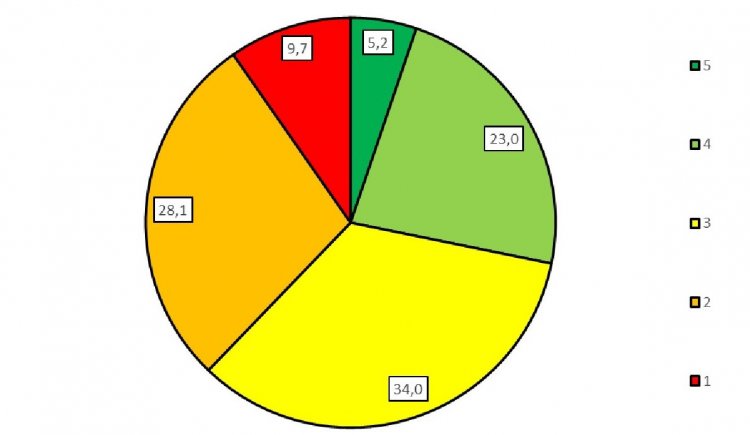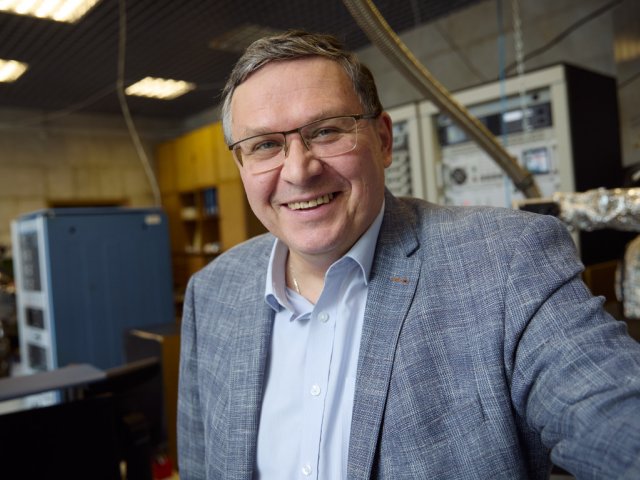Researchers from the VolRC RAS study the phenomenon of social capital to analyze real and potential resources, which can contribute to the sustainable development of the region
In the field of social sciences, most experts analyze the concept of social capital (SC) in the context of social ties. Its basis is trust, supplemented by norms and values, which, in its turn, contributes to the establishment of connections and relationships between people, coordination and cooperation of activities.
Employees of the FSBIS VolRC RAS (Vologda) have been conducting research on the phenomenon of social capital for a long time, trying to understand its essence, factors and formation environment, analyzing its structural components, studying its importance for the development of the society. For example, the family serves as the institutional environment for the formation of social capital. Its foundations are laid there. The social capital acquired within the boundaries of the institutions of family and education of the young generation becomes a resource, on the basis of which young people enter independent life. The study of social capital makes it possible to assess the potential of society and, therefore, to identify resources for its development.
Tatyana Anatolievna Guzhavina – candidate of philosophy, associate professor, leading researcher of the Laboratory for Socio-Economic Studies of the Vologda Research Center of the Russian Academy of Sciences (VolRC RAS, Vologda), told us about the way modern science interprets social capital, about its sources, structural components and importance both for an individual and society.
What prompted your research interest in social capital?
"The research interest arises during a scientific search. A happy accident also plays a role. This is what happened: while preparing an application for a grant from the Russian Science Foundation in 2012, my colleagues and I stumbled upon this topic. It was just being discovered for Russian science. One of the first works was the work of HSE scientists Leonid Polishchuk and Renat Menyashev "Economic importance of social capital," published in the journal "Voprosy Ekonomiki" in 2011. Then I was introduced to the works of those, who are now recognized as classics of the concept – Robert Putnam, James Coleman, Pierre Bourdieu, Francis Fukuyama. Nowadays it is a very popular and productive concept that allows us to study a variety of social processes and spheres. By the way, I recently participated in a webinar by Robert Putnam, where he summarized some of the results of the 30-year development of this concept.
The topic turned out to be interesting and understudied in our scientific environment. The first grant on the subject of social capital was implemented in 2012 in the form of an interregional scientific and practical conference "Social capital as a resource of modernization in the region: problems of formation and measurement" (conference materials are posted in the RSCI, as well as our other publications on this topic). The work on the project allowed us to assemble a team, delve into the topic, and see its prospects.
The next step was a project supported by the RHSF, "Regional Social Capital in Crisis Situations." The project lasted from 2016 to 2018. The team included scientists of VolRC RAS (Tatyana Anatolievna Guzhavina (leader), Irina Nikolaevna Dementieva, Mikhail Vladimirovich Morev) and Cherepovets State University (Dmitry Vladimirovich Afanasiev, Irina Nikolaevna Vorobyeva, Albina Anatolievna Mekhova). The results of the three-year project are reflected in a monograph of the same name. The research was conducted in the Vologda region. And now we are working on a new project. The Russian Foundation for Basic Research (RFBR) supported a grant application with the topic of "Collective Action and Social Capital in Russian Society." For this project we have expanded the boundaries of the research significantly and managed to cover several subjects of the Northwestern Federal District thanks to the support of the Foundation. Population surveys were conducted in Kaliningrad, Murmansk, Petrozavodsk, and the Vologda region. This means that the geography of our research is expanding. Logically, the next step should be an all-Russian study. Each time a creative, enterprising team was assembled. Each time we have received and, hopefully, will continue to receive interesting scientific results. The aim of the current project is to analyze the relationship between social capital and the nature of collective action, identified in the studied territorial communities," Tatyana Guzhavina reported.
Collective Action and Social Capital in Russian Society, Tatyana Anatolievna Guzhavina, Dmitry Vladimirovich Afanasiev, Irina Nikolaevna Vorobyeva and team, VolRC RAS, 2018.
As the researcher pointed out, "the concept of social capital is one of the most promising analytical research concepts used in sociology. It allows us to understand the mechanisms that regulate human interactions in different spheres. It can be used as an independent research strategy; it can be a useful addition to existing approaches to the study of social interactions."
What processes in modern society does the phenomenon of social capital help to comprehend (for example, at the regional level)?
"Social capital is often a local (regional or local) public good (for a particular community). According to many studies, including statistical data, communities with high social capital suffer less from crime, develop better economically, have a higher level of education and life. Their health conditions and life expectancy are higher. By interacting with each other, people create communities, support each other, create a social space around themselves. In other words, they create what we used to call society. When we study the situation in a regional community, we are looking for the resources that can contribute to its sustainable development. Social capital creates the institutional environment, in particular for the functioning of the economy. These are the institutional rules of doing business. Is it two months or two years to prepare the documents? It is clear that in the first case business will work more efficiently. The region will receive its benefits faster in the form of tax deductions, and the consumer – in the form of goods or services provided," the scientist clarified.
What should be understood by the term "social capital"? What theoretical and methodological approach to social capital do you support or what is your point of view on this phenomenon in modern society?
"The term "social capital" is a metaphor. Today scholars speak of aggregate capital, which has such basic forms as economic, material or physical, cultural, human and social. These forms of aggregate capital are described, for example, in the works of P. Bourdieu and V. Radaev and a number of other researchers. The list of forms of capital is expanding. There is administrative, political, symbolic capital. As for social capital, the metaphor turned out to be very apt. The term has caught on and become widespread. Note that all researchers, both foreign and domestic, are close in their understanding of its main components. These are trust as a basic mindset, values and norms of interaction, social networks of contacts.
In the course of the previous project, we proposed the original interpretation of the "social capital" concept. That is what I want to use. We defined social capital as networks of social relations based on trust and characterized by common norms and values, and the level of people's involvement in them; as external effects useful for society and social groups and results generated by social interaction within these networks and associations. At the same time, I would like to point out that it would be wrong to reduce social capital to a single component. None of them can be regarded as social capital in isolation. The notion of social capital is based on the idea that social relations and social norms can provide access to valuable resources, most often of an intangible nature. For example, important or useful information, emotional or psychological support, or help in a certain situation can become such a resource. To babysit, do shopping, find a consultant or executor for a project. When sending a child to school, we want to know the characteristics of a teacher, when going to a hairdresser or makeup artist we look for reviews of their work, when looking for a specialist for a vacant position we ask about their qualities and competencies. In all cases we trust the source of information or our contractor, whose activity becomes predictable to us. We live in a society which creates a lot of risks, it becomes a very important factor of survival. And all of this combined affects our quality of life. In the context of the community, it also increases trust between people," the researcher disclosed.
The basis of social capital is trust as a meta-relationship, i.e., an attitude that is not focused on any particular need. Trust is complemented by values and norms arising in the process of interaction. These are the structural components of social capital. As Tatyana Guzhavina mentioned, "by studying these structural components, we get the opportunity to identify the key characteristics of social interaction. Indeed, we are social creatures, we cannot live outside of society. Nor can we live in society and be free from it. But we build our lives differently through interaction with people and systems around us. Systems are also created as a result of people's interaction. And today we cannot do without them anymore – the government, banks, education, healthcare, etc. It is a long list. There is trust everywhere in the interaction with them, to a greater or lesser degree. For example, in the pandemic situation in which we all find ourselves, we say that we don't trust medicine very much, we scold it. But, as the study shows, we trust the doctor, the paramedic, the nurse we know. And in case of need, we take advantage of the possibilities of this system. And that applies to everything around us. Figuratively speaking, we live in networks of relationships. And that's where our capital arises – these are our contacts and connections, together with the resulting opportunities to achieve goals, to solve problems. And based on the concept of social capital we are able to look into this world."
How one becomes a bearer of social capital, where and how one acquires it. This is a research question. An important condition for the emergence of an individual's social capital is his or her inclusion in a group. According to the scientist, "It does not matter if it is a group of parents whose children go to the same kindergarten, or classmates at school and later groupmates at university, a team in an organization, neighbors in a building or town. What important is the reality of connections and relationships. These networks of contacts create trust between people, and they are willing to share resources with others. Networks institutionalize social capital. Formal structures can also be used for this purpose. For example, people create a club, membership in which means access to a certain circle of communication, to connections and contacts. It is not easy to get into such a club. You need recommendations. Such clubs can also be informal. What may matter is the background or status of a graduate of a certain educational institution, for example. In one of his works, Coleman gave the example of the American diamond market, where diamond traders exchange diamonds for millions of dollars without concluding contracts, on the basis of mutual trust only. Breaking the rules in this environment is equal to losing one's reputation and, consequently, one's business. The loss of trust will exclude the entrepreneur from this environment. This is one of the examples of social capital manifestation and its external effects or its externalities. In the first place, scientists have found them in the economic sphere. The most important of them can be considered a decrease in the cost of doing business.
Moreover, social capital has many of the attributes inherent in any type of capital. For example, it requires investment, but of a specific nature. For social capital – it is the time we spend on maintaining contacts, their number. The fact is that the main distinguishing characteristic of social capital from its other forms lies in its social nature. It cannot belong to anyone. It cannot be individual. Some researchers of social capital consider it possible to be tied to a person. A person is a possessor. But in fact, one’s contacts mean nothing without contractors. A person can become something like Robinson Crusoe if they are deprived of them. SC arises only when a person interacts with other people. Social capital is a public good. But it exists only as long as we adhere to the norms and rules developed with our participation, which are present in networks of relationships that we maintain by preserving connections and contacts. This property was noted by J. Coleman."
Are there any fundamental differences in the nature of SC research between Russian and foreign specialists?
"Foreign scientists have widespread research on the effectiveness of social capital in the use of natural resources. Specific cases are related to collective actions on the use of forest, water, pasture, and fish resources. Studies examine how rules of interaction emerge, how norms are established. Many of these studies have an anthropological focus.
If we talk about the methodology of research on social capital, about its interpretation, it is hard to distinguish global differences in the positions of Russian and foreign scientists. Here, I would say, we tend to go in the same direction. The theoretical framework is similar," the scientist specified.
What types of social capital are distinguished and which of them are represented most widely in society today?
" Social capital is a rather complex phenomenon. Scientists have paid attention to the different effects that arise. And this has led to the idea that there are different types of social capital. Today this is already a well-established point of view. It was R. Putnam who proposed to distinguish between types of social capital. He distinguished two. The first type is bonding, or limiting social capital. In the first case we have social capital limited to a certain community. It is typical of homogeneous groups, for example, family or professional groups. The example of the diamond business described by Coleman shows the social capital of this kind of community. It can also be called closed social capital. The second type is bridging social capital, which can be defined as ties that form over a variety of social groups. It can also be called open social capital. According to Putnam, this type refers to social networks that bring different people together. There are other, slightly different designations of these types, but they are essentially similar. For example, Mark Granovetter talks about strong and weak ties. Weak ties serve as an effective channel for information flows, which is very important for the implementation of collective action. There is a very interesting aspect here, where direct control is replaced by proactive self-organization. But the point is that different types of social capital are based on different networks of contacts and different radius of trust in them.
It is the connecting social capital, i.e., the second type, that has an economic effect. It has a positive effect on economic growth. And the limiting social capital gives a negative social effect. And you can see it in the growth of the cost of controlling contractors in business, for example. In the creation of excessive demands, in the denial of loans, etc. And the contractors here may not necessarily be only entrepreneurs. More often than not, one of the participants is the state, represented by some of its agencies," Tatyana Guzhavina said.
How is social capital measured?
"If we talk about our region, we conduct the analysis on the basis of our own methodology, which allows us to see the structural distribution of accumulated social capital among its bearers. When implementing the second project, our research team developed the original methodology for measuring SC. It is described explicitly in the monograph "Regional Social Capital in Crisis Conditions." We measure social capital by means of an integral index. This is a complex indicator, which allows us to calculate an integral index of social capital for each respondent (about 49 indicators are taken into account). On the basis of the obtained data, we determine the groups of carriers of social capital depending on the level of its accumulation.
T.A. Guzhavina, candidate of philosophy, associate professor, assistant professor, grant manager; D.A. Lastovkina, senior lab assistant, member of the research team; and N.N. Yasnikov, master of sociology, research engineer for the development of the research tools.
The integral index of social capital (ISC) is calculated with a formula that includes its main components: trust, networks, values and norms.
ISC = (Itrust + Inetworks + Ivalues) / 3
If we present the data in the form of a diagram, the distribution is as follows (see Fig. 1).
Figure 1. Structure of the Vologda Oblast population by type of social capital (in % of respondents, 2021. Compiled by the author)
Type 1 is its minimum level, 5 is its maximum level. The first type includes those respondents who predominantly choose the answer options "I do not trust" and "I do not participate." So, the 5th group is the most active citizens, respectively. The intermediate positions are characterized by different levels of social capital, which is connected with different levels of involvement into networks of relations and with different radius of trust. The wider the radius of trust is, i.e., the more people the respondent trusts, the higher his social capital is. The correlation is direct here.
But in reality, things are not so good. The pandemic has highlighted many problems and this is reflected in our research. One of the qualities of social capital is the willingness to act collectively to overcome problems. In a pandemic, for example, it is the willingness to comply with safety measures. The question was asked in November-December 2020, at the height of the second wave. The dependence of readiness, and not only readiness, but also the practical implementation of individual protection measures is quite clear (see Fig. 1).
Table 1. Distribution of responses to the question "Please tell us which of the following measures to combat coronavirus you comply with... (depending on the level of social capital, in % of respondents. Source: data of the public opinion poll. VolNTs RAS, September 2021)
|
Answer options |
Level of social capital |
||||
|
|
1 |
2 |
3 |
4 |
5 |
|
Face-mask regimen |
82 |
88 |
90 |
89 |
89 |
|
Social distancing |
48 |
57 |
64 |
63 |
61 |
|
Self-isolation |
28 |
28 |
32 |
28 |
39 |
|
I wear gloves, use hand sanitizers |
31 |
37 |
42 |
44 |
52 |
|
I wear gloves and consider the use of hand sanitizers reasonable |
22 |
39 |
38 |
40 |
35 |
|
I work from home |
9 |
15 |
14 |
18 |
27 |
By the way, a recent article by V. Dementiev, published in № 3 for 2021 in the journal VolRC RAS "Economic and social changes: facts, trends, forecast" provides data on the relationship of distancing and trust. The author cites data on the United States. As you can see, there is a connection.
Social capital manifests itself in the use of certain practices under conditions of risk. Let us consider the risks created by the pandemic. The pandemic showed the atomization of society and this is reflected in a decrease in the level of interpersonal trust; the pandemic showed our alienation from the authorities, whose task is to organize society in crisis situations, which is reflected in a decrease in institutional trust; the pandemic showed the insufficient assessment of the threat to their lives and health and it was reflected in limited or formal use of protective practices or in their complete ignoring; the pandemic showed the role and importance of adequate information about the danger of disease and its consequences. 74% of the respondents draw information from their inner circle. Only 9% of respondents trust the opinion of the expert scientific community. The low level of trust in the opinions of experts is distressing.
The lack of awareness of the negative effects of the pandemic affects people's unity, and this is a condition for collective action (see Fig. 2).
Figure 2: Distribution of responses to the question "Did people in your close environment become more or less united during the coronavirus pandemic? (depending on the level of social capital, in % of respondents..)
Inadequate reactions lead to unwarranted optimism, which manifests itself in a refusal to protect oneself and one's loved ones, not to pose a threat to strangers. These factors greatly contribute to the spread of infection and refusal to vaccinate or delaying it, which is equivalent to denial. In the summer of 2021, 28% of respondents said they had vaccinated, 36% intended to, and another 36% did not and do not plan to vaccinate. According to official data, 28.4% of the region's population has been vaccinated. A complete match with our survey data," the researcher explained.
What is the relationship between social capital and collective action (CA)? What impact do CAs (including virtual channels of interaction now) have on the formation of social capital?
"I would like to make a note about virtual channels of interaction. In my opinion, they do not contribute to the formation of social capital in the context in which we understand it in our study. They only create the illusion of communication and interaction. When they are used as an auxiliary tool, then yes. But not as an independent source. That's why there is so much fraud out there. The anonymity and temporality of the interaction is great. If we are talking about collective action, then social capital is the main condition for the realization of collective action. P. Bourdieu drew attention to the collective nature of social capital. Collective action requires mutual understanding. And it is largely achieved through the establishment of norms. In the broad sense of the word, we create norms ourselves. We do not get them from nowhere. Norms are the basis for social capital. It forces us to give in, to give up our selfish purpose, to understand the other. A collective is impossible without a norm. Are there norms in networks?
Where do we meet the norms? Take the family. There are norms of mutual assistance, support, unselfishness. This is what the younger generations are brought up on. These norms are used further. There are self-help groups. As an example, let us take the groups of help in searching for the missing. Social capital is very strong in these groups. Networks are used here as a channel of information. New movements can arise on the basis of common interest. A lot of norms deny egoistic behavior. Society would be impossible without it. When mankind learned to help others, the emergence of the rational mankind started. But the modern world, oriented toward consumerism, greatly increases atomization in society, as well as its fragmentation.
Collective action is important for the economy. Our regional entrepreneurs are more focused on individual action to strengthen the position of their business within the already established "rules of the game", to strengthen differentiated relationships with government representatives. In fact, in this situation we encounter such a paradox of collective action as the absence of real action by entrepreneurs to achieve their collective interests. Collective action presupposes the creation of new norms. And we have a hard time doing this. The problem of the "stowaway" interferes. Social capital is a public good. Therefore, it is possible not to invest in its maintenance, but to use it. This is the opinion of many people today. But if everyone or almost everyone is inclined to be like that, the initiative will stall and the whole thing will disappear," the scientist clarified.
What can we say about the potential of social capital of the territorial community in our country at the moment?
"It's hard to be specific about the country. Yes, it exists. But it has to be studied. Given the territorial connection, each community will have social capital with its own specifics. But this is what will affect the development of the territory. The study of the concept of "social capital" is important for understanding the processes that have been taking place in our country lately. It should be kept in mind that we live in a rapidly changing society, where norms are not yet established, vague, and social capital is a necessary condition for the mobilization of collective resources. Social capital can compensate for the normative vacuum; it also contributes to the formation of a new institutional environment in Russia. Alexander Auzan, the Dean of the Faculty of Economics at Moscow State University and a well-known proponent of neo-institutionalism and the concept of social capital, speaks extensively and frequently on this matter.
Figure 3. The structure of the Vologda Oblast population by type of social capital (in % of respondents, 2020.)
A comparison of the two measurements in 2020 and 2021 shows marked changes in the extreme groups. It is clear that coming out of the next pandemic wave improved the situation. Broken contacts and ties were restored. Now, with the increase in cases of disease, we will wait for another downturn. The pandemic has hurt trust. Especially institutional trust. For example, 59% trusted the president in 2020, 53% trusted the government, and 53% trusted the governor. The data of 2021 on trust in these institutions look like this: 67% trust the president, 61% trust the government, 58% trust the governor. The restoration of the situation in the regional community, on the one hand, and our adaptation to it, on the other, led to a certain growth of institutional trust and, consequently, to the growth of social capital. In other words, the restoration of social ties and relations, which is reflected in the growth of trust. The same is true of interpersonal trust," Tatyana Guzhavina believes.
Thus, the study of social capital reveals the extent to which Russians are active and adaptive to the changes taking place in society, especially in the context of the ongoing pandemic, and confirms the need for real human contacts based on trust as a fundamental condition for building meaningful social relationships.
All images are provided by Tatyana Guzhavina


























